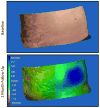Three-dimensional volumetric quantification of fat loss following cryolipolysis
- PMID: 24535759
- PMCID: PMC4123113
- DOI: 10.1002/lsm.22207
Three-dimensional volumetric quantification of fat loss following cryolipolysis
Abstract
Background and objectives: Cryolipolysis is a noninvasive and well-tolerated treatment for reduction of localized subcutaneous fat. Although several studies demonstrate the safety and efficacy of this procedure, volumetric fat reduction from this treatment has not been quantified. This prospective study investigated the change in volume of fat after cryolipolysis treatment using three-dimensional (3D) photography.
Materials and methods: A prospective study of subjects treated with cryolipolysis on the flank (love handle) was performed at Massachusetts General Hospital. Volume measurements were performed with a Canfield Scientific Vectra three-dimensional camera and software to evaluate the amount of post procedure volume change. Clinical outcomes were assessed with caliper measurements, subject surveys, and blinded physician assessment of photographs.
Results: Eleven subjects were enrolled in this study. Each subject underwent a single cycle of cryolipolysis to one flank. The untreated flank served as an internal control. The follow-up time after treatment was 2 months. The mean amount of calculated absolute fat volume loss using 3D photography from baseline to 2 months follow-up visit was 56.2 ± 25.6 from the treatment site and 16.6 ± 17.6 cc from the control (P < 0.0001). A mean absolute difference of 39.6 cc between the treated and untreated sides was calculated at 2 months post-treatment. Comparison of caliper measurements from baseline to 2 months post-treatment demonstrated significant reduction of the treated flank from 45.6 ± 5.8 mm at baseline to 38.6 ± 4.6 mm at 2 months post-treatment (P < 0.001). The untreated flank did not show significant reduction with caliper measurements demonstrating 45.3 ± 5.0 mm at baseline and 44.6 ± 5.1 mm at 2 months post-treatment (P = 0.360). No unexpected side effects or adverse events were reported. Post-treatment satisfaction surveys demonstrated 82% of subjects were satisfied with the results.
Conclusions: Cryolipolysis is a safe, well-tolerated, and effective noninvasive fat removal methodology that on average leads to 39.6 cc of fat loss of the treated flank at 2 months after a single treatment cycle.
Keywords: cold induced fat loss; fat removal; imaging; noninvasive; volume of fat.
© 2013 Wiley Periodicals, Inc.
Figures





References
-
- Alderman AK, Collins ED, Streu R, et al. Benchmarking outcomes in plastic surgery: national complication rates for abdominoplasty and breast augmentation. Plast Reconstr Surg. 2009;124:2127–33. - PubMed
-
- Desrosiers AE, 3rd, Grant RT, Breitbart AS. Don’t try this at home: liposuction in the kitchen by an unqualified practitioner leads to disastrous complications. Plast Reconstr Surg. 2004;113:460–1. - PubMed
-
- Jalian HR, Avram MM. Body contouring: the skinny on noninvasive fat removal. Semin Cutan Med Surg. 2012;31:121–5. - PubMed
-
- Epstein EH, Jr, Oren ME. Popsicle panniculitis. N Engl J Med. 1970;282:966–7. - PubMed
-
- Beacham BE, Cooper PH, Buchanan CS, Weary PE. Equestrian cold panniculitis in women. Arch Dermatol. 1980;116:1025–7. - PubMed
Publication types
MeSH terms
Grants and funding
LinkOut - more resources
Full Text Sources
Other Literature Sources
Medical

